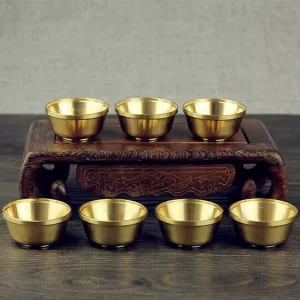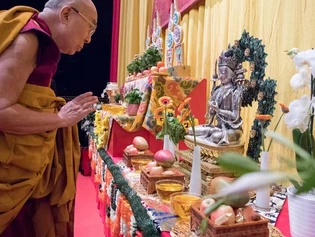Making offerings to the Three Jewels: Buddha, Dharma, and Sangha – is a magnificent daily practice.
A wonderful day to start a day is to cultivate bodhicitta and generosity for the day ahead. By doing it, we create positive karma and help other sentient beings.
Making offerings is a practice for accumulating positive karma and for purifying obstacles. Enlightened beings, such as the Buddha and Bodhisattvas, do not need our offerings, respect, or prostrations. We do the practices solely because of the transformative effect they have on our own body, speech, and mind.
What can I offer?
•Flowers. May remain on the altar until they begin to wilt. Then put the flowers outside in a place where no one will step on them. Represent the qualities of the Buddhas and bodhisattvas.
•Lights. Signifies the fragrance of pure ethics.
•Food. May remain for several days. Then, ask the Buddha’s permission to remove the food. You may eat it yourself. Represents the nourishment of meditative concentration.
•Water. Represents blissful wisdom nectar to all the Buddhas and bodhisattvas.
•Incense. Symbolizes wisdom.

In the Tibetan tradition, there is a special offering of seven bowls of water. It is said that by just seeing a statue or a painting of Buddha, you immediately collect numberless merits. Then, if you prostrate, make offerings, offer incense, and so forth to a statue or a painting of Buddha, you collect far greater merit than from simply seeing the statue or painting.
*Merit refers to positive karma (or energy) that is accumulated as a result of positive or wholesome actions of body, speech, or mind.
Respect the Buddha Statues
Never touch, sit near, or climb on a Buddha statue or the raised platform the statue sits on. Get permission before taking photographs and never do so during worship. When exiting, you should walk backward and get some distance between you and the Buddha before turning your back.
You might think of worship if you see Buddhists bowing to Buddha statues, but there’s something else going on. In some schools of Buddhism, bowing and making offerings are physical expressions of the dropping away of a selfish, ego-centered life and a commitment to practice the Buddha’s teachings.
There’s the story of somebody who, having nothing else to offer, offered a medicinal drink to four ordinary, fully ordained monks. Just from that, in his next life, that person was born as King Kaushika, the most powerful, wealthy king in India. It doesn’t say that those monks were highly attained monks; they were just four ordinary monks.
In this case, offerings mean helping other people, generating bodhicitta, and showing compassion and generosity for every single sentient being.
No doubt offering a single grain of rice to Buddha, Dharma, and Sangha immediately become a cause of enlightenment, a cause of the highest success, as well as a cause of liberation from samsara and all the happiness of future lives, but it’s the same even with statues, stupas, and scriptures. This happens not by the power of your mind but by the power of the object.
Nearly every temple has a donation box for receiving help from the public. These donations keep the temple running, usually on a very thin budget. If you would like to help monastics, giving a small amount would mean a lot.
If you have holy objects in your house such as Buddhists book, Buddha statues, malas, singing bowls, and so on, it is important to respect them. Don’t put them on the floor without anything under them. We must not pollute our minds by disrespecting them.




